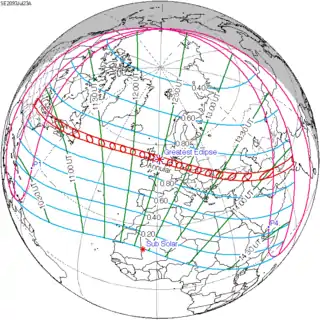| Solar eclipse of February 18, 2091 | |
|---|---|
 Map | |
| Type of eclipse | |
| Nature | Partial |
| Gamma | 1.1779 |
| Magnitude | 0.6558 |
| Maximum eclipse | |
| Coordinates | 71°12′N 17°48′W / 71.2°N 17.8°W |
| Times (UTC) | |
| Greatest eclipse | 9:54:40 |
| References | |
| Saros | 122 (62 of 70) |
| Catalog # (SE5000) | 9712 |
A partial solar eclipse will occur on February 18, 2091. A solar eclipse occurs when the Moon passes between Earth and the Sun, thereby totally or partly obscuring the image of the Sun for a viewer on Earth. A partial solar eclipse occurs in the polar regions of the Earth when the center of the Moon's shadow misses the Earth.
Related eclipses
Solar eclipses 2091–2094
This eclipse is a member of a semester series. An eclipse in a semester series of solar eclipses repeats approximately every 177 days and 4 hours (a semester) at alternating nodes of the Moon's orbit.[1]
| Solar eclipses 2091–2094 | |||||
|---|---|---|---|---|---|
| 122 | February 18, 2091 Partial |
127 | August 15, 2091 Total | ||
| 132 | February 7, 2092 Annular |
137 | August 3, 2092 Annular | ||
| 142 | January 27, 2093 Total |
147 | July 23, 2093 Annular | ||
| 152 | January 16, 2094 Total |
157 | July 12, 2094 Partial | ||
References
- ↑ van Gent, R.H. "Solar- and Lunar-Eclipse Predictions from Antiquity to the Present". A Catalogue of Eclipse Cycles. Utrecht University. Retrieved 6 October 2018.
External links
This article is issued from Wikipedia. The text is licensed under Creative Commons - Attribution - Sharealike. Additional terms may apply for the media files.
.jpg.webp)

